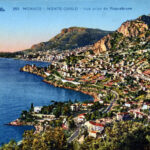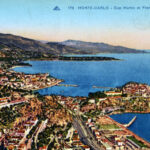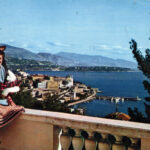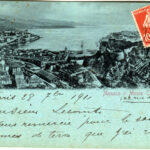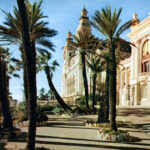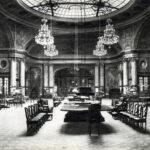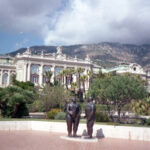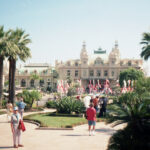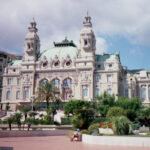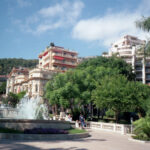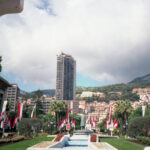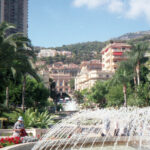Guide to the Cote d’Azur. Sights, what to see, a map, sightseeing tours, how to get from Nice and Cannes.
Monte Carlo (Monte – Carlo) – a district of one of the smallest states in the world (after the Vatican), officially belongs to the administrative territory of the Principality of Monaco. The unofficial name of the whole area refers to the largest area – the Monte Carlo quarter (which corresponded to the former eponymous), which also includes La Rousse-Saint-Roman, Larvotto-Bas-Moulin and Saint-Michel. The permanent population of Monte Carlo is 3.5 thousand people, and in total about 15 thousand live in the quarter. There are 4 traditional quarters in Monaco: from west to east – Fontvieille (newest), Monaco-Ville (old), La Condamen and, accordingly, Monte Carlo.
- From Nice to Monaco Monte Carlo Private Tours
- Monte Carlo, Cape Martin and the Italian border (M.B. collection)
- view of Monte Carlo from Monaco, Photo 60s
- Monaco and Monte-Carlo on the posr card before World War I
Brief history: By the 1850s, the ruling dynasty of Monaco was almost completely bankrupt as a result of the loss of 2 cities – Menton and Roquebrune, which provided most of the principality’s income from their lemon and orange plantations. At that time, a number of small towns in Europe, such as Baden-Baden and Homburg, flourished due to the casinos located on their territory. In 1856, Charles III, Prince of Monaco, granted Napoleon Langlois and Albert Aubert a concession to arrange sea baths for the treatment of various diseases and build a German-style casino. The first casino opened in La Condamen in 1862, but did not bring any significant income. Today it is located in the area called “The Caves” in Monte Carlo. Income began to flow only after repeated movements of it in subsequent years. Success and fame came to the casino slowly, largely due to the inaccessibility of this place in Europe. However, the construction of the railway in 1868 greatly stimulated the influx of players to Monaco, which was reflected in its ever-growing wealth. In 1883, Saint-Charles Church was built on Avenue Saint-Charles in Monte Carlo. In the centennial anniversary of its existence, it was reconstructed. In 1911, when, in accordance with the constitution of Monaco, the principality was divided into 3 municipalities, the municipality of Monte – Carlo was formed, which included the districts of La Rousse – Saint-Roman, Larvotto – Ba Moulin and Saint-Michel. In 1917, all the municipalities were merged into one, following the accusation of the government that it was acting on the principle of “divide and rule”, and they were henceforth given the status of neighborhoods.
Today, Monaco is divided into 10 quarters, the 11th quarter was planned to be created (but is currently postponed) at the expense of the territory taken from the sea. From 1900 to 1953 all parts of Monaco were connected by tram lines. In 2003, the construction of a new berth for large ships was completed in the harbor of Monte Carlo.
Monte-Carlo (literally – “Mount Charles”) is located on a cliff at the foot of the Alpes-Maritimes along the French Riviera. At the western end of the block is the world-famous Casino Square and the gambling hub that has made Monte Carlo “the international epitome of extravagant boasting and reckless dissipation of wealth.” It is also the site of the Hotel de Paris, the Café di Paris and the Salle Garnier (the casino is located in the building itself, also owned by the Monte Carlo Opera). The eastern part of the quarter includes the commune of Larvotto with Monaco’s only public beach, as well as the new Convention Center (Grimaldi Forum) and the Monte-Carlo Bay Hotel. The quarter on the eastern border passes into the French city of Beausoleil (sometimes called the Upper Monte Carlo) and just 8 km (5 miles) to the east is the western border of Italy.
Sports, rally and cars. Monte Carlo is the owner of most of the “Ring of Monaco”, which hosts the Formula 1 Grand Prix of Monaco. In addition, it also hosts the World Boxing Championship, the Grand Final of the European Poker Tour, the World Backgammon Championship and the Monaco International Motor Show, fashion shows and other events. Despite the fact that the Monte-Carlo tennis tournament is considered to be officially held here, in reality it takes place in the French commune of Roquebrune-Cap-Martin.
The Monte Carlo Rally was one of the longest and most respected car rallies from 1973 to 2008. became such again in 2012. From 2009 to 2011. there were seasonal World Rally Championships, which were one-act Intercontinental Rally. However, the rallies take place outside the Monte Carlo quarter, mostly on French roads. These places are often visited by royalty, members of the general public, movie stars.
Top attractions in Monte Carlo
Monte Carlo is one of the leading European resorts, although many of the main tourist spots are found in other parts of Monaco, including attractions such as the Monaco Cathedral, the Napoleonic and Oceanographic Museums (there are 90 aquariums and almost 4 thousand species of fish), the Prince’s Palace (it has 3 salons – Blue, Louis the 15th and Mazarin, the Palatine Chapel, the Throne Room, the tower of St. Mary with the princely standard above it and the courtyard with geometric figures) – they are all located in Monaco – Ville.
- Casino Monte Carlo, legendary and famous from the movies
- Casino from the Palms
- 2. Casino game room
- Little Africa Garden and Sculptures
- Casino Square, walking tour
- Opera Monte Carlo, theater like in Paris (our archive 1999)
- Fountain in the garden
- Gardens and parks, in the background the hotel and the Alps
- Palm trees and hillside hotels
Culture. Theater. Opera. The building “Opera Monte-Carlo” (or “Hall Garnier”) was built according to the project of the architect Charles Garnier, who also designed the Paris Grand Opera, also called the “Palace Garnier”. Although smaller, the Salle Garnier is very “palace”-like in the red and gold style of the decorations, frescoes and sculptures all around the room. It was opened on January 25, 1879 with a performance by Sarah Bernard dressed as a nymph. The first opera staged here was Chevalier Gaston by Robert Plunkett, which premiered on February 8 of the same year and was followed by three more in its first season. Influenced by the first director of the Opera, Jules Cohen (who played an important role in attracting Adeline Patti), and then by Raoul Günsburg, who was the new director from 1883, and Princess Alice, who loved the opera of the American wife of Prince Albert I, successor of Charles III, Opera Monte Carlo moved to the forefront of the world opera community. Günzburg remained as director for 60 years.
In the early years of the 20th century, the Salle Garnier saw great performers such as Nellie Melba and Enrico Caruso in La bohème and Rigoletto (1902), Fyodor Chaliapin at the premiere of Don Quixote by Jules Massenet (1910). This production left part of a long-term alliance between the Salle Garnier and Massenet with his operas, two of which were presented to the public after his death. Other famous singers appeared in Monte Carlo in the last century: Titta Ruffo, Geraldine Farrar, Mary Garden, Tita Skipa, Beniamino Gigli, Claudia Muzio, Georges Till, Lily Pons, etc.
In addition to Massenet, the composers whose works were presented in Monte Carlo were Saint-Saint (“Helen”, 1904), Mascagni (“Amica”, 1905), Puccini (“The Swallow”, 1917). Since its opening, the Opera has hosted 45 world productions of operas. René Blum was the director of the ballet for the Opera. The Salle Garnier usually has 5 or 6 operas per season.
The best hotels. Another attraction of Monte Carlo is the Hotel de Paris (Hotel Paris), built in 1864 by Charles III, located on the western side of the Casino Square. It belongs to the Monaco Sea Bathing Society and is part of the Grand Palace luxury hotel chain, which includes the Hermitage hotels, the Monte Carlo Coastal Hotel on the coast of the bay of the same name, the Metropol and the Fairmont. The Hotel de Paris has 106 rooms, divided into 4 groups depending on the views from the room, decorations and luxury: exclusive panoramic view of the city (20 rooms), upper courtyard (29 large rooms), exclusive sea view (59 rooms) and exclusive casino view (6 rooms). In addition, there are 74 suites and junior suites, similarly grouped, offering more luxury than rooms. There are also single or double rooms, as well as courtyard rooms and junior suites “Sea – Casino”, as well as a presidential “suite”.
Movies, TV series, spies and postcards
The image and views of Monte Carlo have been reflected in many films and television series, and most fully in the 2011 film of the same name. The casino is well shown in the James Bond series, famous films: Never Say Never Again (1983), Goldeneye (1995). The film To Catch a Thief (1954) by Alfred Hitchcock with M.-K. and its famous casino features stars Cary Grant and Grace Kelly, the future Princess Grace of Monaco. There is a scene in the film in which Grace drives very quickly and dangerously along the steep and winding roads of Monaco, which surrounded the peaks of Monte Carlo. This is an interesting coincidence with Grace’s actual death in 1982. The film Grand Prix (1966) was filmed in the same locations and featured James Garner, Eva M. Saint and Yves Montand.
In 1970, Chevrolet introduced a car called the Chevrolet Monte Carlo, which went through 6 generations of production until 2007. The Monte Carlo Monaco World Prix 1 also features in the 2010 film Iron Man – 2″. The city has also been used for movies such as I Spy, Cars 2 and Monte Carlo. One local hotel is shown in the cartoon Madagascar-3: Europe’s Most Desirable. In the film The Bold and the Beautiful (2016), many of the scenes were also filmed in the same locations.

